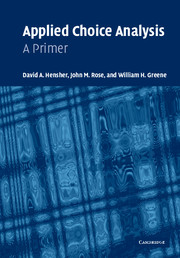15 - The mixed logit model
Published online by Cambridge University Press: 05 September 2012
Summary
We used to think that if we knew one, we knew two, because one and one are two. We are finding that we must learn a great deal more about “and.”
(Sir Arthur Eddington, 1882–1944, quoted in The Harvest of a Quiet Eye, London, Institute of Physics, 1977).Introduction
The most popular choice models in use are the multinomial logit (MNL) and nested logit (NL). This is likely to remain true for a long time for the majority of practitioners. These models provide closed-form choice probability calculations and offer a framework within which many interesting behaviorally based questions can be investigated and answered. Given that the challenges to input high-quality data on the relevant set of attributes of alternatives and characteristics of individuals extends to all choice models, no matter how simple or complex the model structure might be, there is a large amount of credibility invested in the estimation and application of the familiar, tried and true MNL and NL models. But there is room for alternative choice models, provided that they add value to the established workhorses. Some of the large number of new choice models proposed in the literature have turned out to be tools that have aided the research community in its search for truly improved behavioral specifications. One such choice model is the mixed logit model. (It is also referred to as the “random parameter logit,” “mixed multinomial logit,” or “hybrid logit” model.
- Type
- Chapter
- Information
- Applied Choice AnalysisA Primer, pp. 605 - 622Publisher: Cambridge University PressPrint publication year: 2005
- 4
- Cited by



